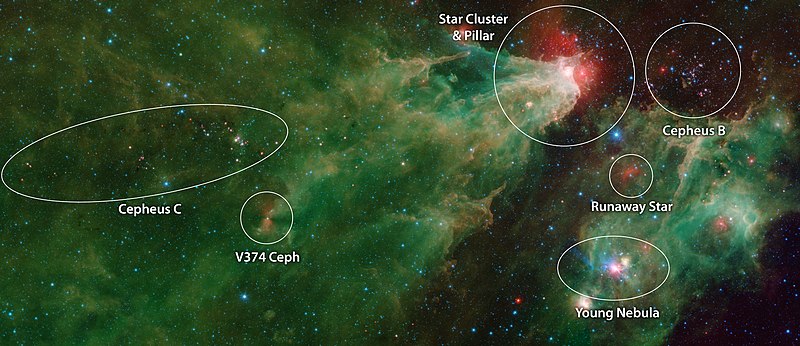Cepheus (constellation)
| Constellation | |
27th) | |
| Main stars | 7 |
|---|---|
| Bayer/Flamsteed stars | 43 |
| Stars with planets | 1 |
| Stars brighter than 3.00m | 1 |
| Stars within 10.00 pc (32.62 ly) | 3 |
| Brightest star | α Cep (Alderamin) (2.45m) |
| Messier objects | 0 |
| Meteor showers | 0 |
| Bordering constellations | Cygnus Lacerta Cassiopeia Camelopardalis Draco Ursa Minor |
| Visible at latitudes between +90° and −10°. Best visible at 21:00 (9 p.m.) during the month of November. | |
Cepheus is a
The constellation's brightest star is
History and mythology
Cepheus was the
Features

There are three
There are several prominent double stars and binary stars in Cepheus. Omicron Cephei is a binary star with a period of 800 years. The system, 211 light-years from Earth, consists of an orange-hued giant primary of magnitude 4.9 and a secondary of magnitude 7.1. Xi Cephei is another binary star, 102 light-years from Earth, with a period of 4,000 years. It has a blue-white primary of magnitude 4.4 and a yellow secondary of magnitude 6.5.[11]
Kruger 60 is an 11th-magnitude binary star consisting of two red dwarfs. The star system is one of the nearest, being only 13 light-years away from Earth.

Deep-sky objects

- NGC 188 is an open cluster that has the distinction of being the closest open cluster to the north celestial pole, as well as one of the oldest-known open clusters.
- NGC 6946 is a spiral galaxy in which ten supernovae have been observed, more than in any other galaxy. It is sometimes called the Fireworks Galaxy.[15][16]
- IC 469 is another spiral galaxy, characterized by a compact nucleus, of oval shape, with perceptible side arms.
- The nebula NGC 7538 is home to the largest-yet-discovered protostar.[17]
- NGC 7023 is a reflection nebula with an associated star cluster (Collinder 429); it has an overall magnitude of 7.7 and is 1,400 light-years from Earth. The nebula and cluster are located near Beta Cephei and T Cephei.[18]
- S 155, also known as the Cave Nebula,[19] is a dim and very diffuse bright nebula within a larger nebula complex containing emission, reflection, and dark nebulosity.
- The quasar 6C B0014+8120 is one of the most powerful objects in the universe, powered by a supermassive black hole which is as massive as 40 billion Suns.[20]
Visualizations

Cepheus is most commonly depicted as holding his arms aloft, praying for the deities to spare the life of Andromeda. He also is depicted as a more regal monarch sitting on his throne.[4]
Equivalents
In
Namesakes

- USS Cepheus (AKA-18) and USS Cepheus (AK-265), United States Navy ships.
- Update 3.4 "Cepheus" of the videogame Stellaris[citation needed]
See also
References
- ^ a b "Cepheus, constellation boundary". The Constellations. International Astronomical Union. Retrieved 15 February 2014.
- S2CID 40214759. This paper does acknowledge the possibility of an optical illusion that would cause an overestimation of the mass.
- S2CID 14438667.
- ^ a b Staal 1988, pp. 14–18
- ISSN 0004-6361.
- Bibcode:1995yCat.5050....0H.
- S2CID 123149047.
- ISSN 0004-6361.
- ^ "First Discoveries: Gamma Cephei A b". exoplanets.nasa.gov. Retrieved January 29, 2024.
- ^ Ridpath & Tirion 2001, pp. 112–115.
- ^ a b c Ridpath & Tirion 2001, pp. 112–113.
- ISSN 0004-6256.
- ISSN 0004-637X.
- ^ "Smoky Shells". ESA/Hubble Picture of the Week. Retrieved 13 December 2012.
- ^ Michaud, Peter (1 January 2015). "Gemini Observatory Welcomes 2005 with Release of Galactic Fireworks Image". NASA. Retrieved 2017-10-15.
- ^ Boen, Brooke (20 May 2015). "NGC 6946: The 'Fireworks Galaxy'". NASA. Retrieved 2016-12-08.
- S2CID 119284322.
- ^ Levy 2005, p. 107.
- ISBN 9781441903266.
- S2CID 14438667. 17:53:24 GMT.
- Levy, David H. (2005). Deep Sky Objects. ISBN 1-59102-361-0.
- Ridpath, Ian; Tirion, Wil (2001), Stars and Planets Guide, Princeton University Press, ISBN 0-691-08913-2
- Ian Ridpath and Wil Tirion (2007). Stars and Planets Guide, Collins, London. ISBN 978-0-691-13556-4.
- Staal, Julius D.W. (1988), The New Patterns in the Sky: Myths and Legends of the Stars (2nd ed.), The McDonald and Woodward Publishing Company, ISBN 0-939923-04-1
